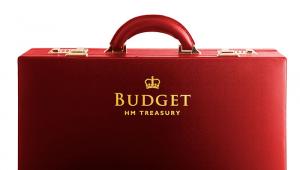
Soon after he became chancellor, Philip Hammond committed to hold only one fiscal event a year.
After presenting a Spring Statement to the House of Commons, which contained little more than updated fiscal and economic forecasts, he appears to be sticking to his word.
However, the statement gave some clues into the chancellor’s thinking – and the questions he will have to address.
For the second time in five months, the Office for Budget Responsibility has revised down its forecast for public borrowing, despite lowering their forecast for economic growth this year.
The latest OBR figures show that – if the chancellor had made no policy decisions since October – public borrowing would now be forecast to be around £8bn a year lower by 2023-24 than it expected at the last Budget.
This followed an £18bn a year improvement last October, and a £4.5bn improvement last March.
Most of the good news this time has come from stronger than expected receipts of taxes on earnings, with earnings growth stronger than expected – particularly for high earners who hand more of their income over to the taxman.
This was the eighth time since the OBR’s creation in 2010 that the committee has revised down its underlying forecast for borrowing.
'Unprotected services – outside the NHS, defence and overseas aid – are still notionally facing real terms cuts to their budgets.'
But what goes down can also go up: there have been 11 occasions on which the OBR has revised their forecast the other way.
At last October’s Budget, Hammond chose to spend the windfall – delivering on the prime minister’s promise of extra money for the NHS without having to raise taxes.
But this time he has banked most of the good news, choosing to offset just a quarter of the borrowing reduction (£2.1 billion in 2023-24) with higher spending.
The Institute for Government has for several years called for just a single fiscal event each year, so it is welcome that the chancellor resisted the temptation to splurge the latest windfall through major new spending pledges or tax cuts.
Continued uncertainty about when and how the UK will leave the EU also adds a further reason to hold back, for now, on deciding how to deploy any fiscal firepower.
The chancellor took the opportunity to emphasise the economic and fiscal costs of exiting the EU without a deal, and to dangle the prospect of more money for public services, investment and lower taxes if MPs can coalesce behind a Brexit deal.
“If we leave the EU with a deal...we will see a deal dividend: An economic boost…and a fiscal boost”, he claimed.
But the truth is that the OBR’s economic forecasts already assume that the UK will leave with a deal and benefit from an orderly transition to a new trading relationship with the EU – there would be little further economic upside from signing the deal.
However, the chancellor does have significant headroom against his short-term fiscal target of reducing borrowing to no more than 2% of national income in 2020-21.
The latest forecasts show he has £26.6bn to spare in that year – up from £15.4bn at the Budget. Rather than being held back as a no deal contingency fund, some of that money, the chancellor has said, could be released for other purposes if exiting the EU without a deal is taken off the table.
But that fiscal headroom only exists in the short-term. Even after the latest improvement in the OBR forecasts, there is still some way to go to achieve the chancellor’s longer-term objective of eliminating borrowing altogether.
Unprotected services – outside the NHS, defence and overseas aid – are still notionally facing real terms cuts to their budgets.
But there were hints in Mr Hammond’s statement that he may be preparing for a more fundamental rethink of his fiscal objectives.
He talked about “real choices” facing the nation – if MPs sign up to a Brexit deal – over how much additional money should be allocated to “spending on public services, capital investment…and keeping taxes low”.
He said he was still committed “to continuing to keep our debt falling”, but debt can fall as a share of national income without borrowing being eliminated altogether.
We have called for the chancellor to clarify his targets for borrowing and debt beyond 2020-21. That will determine how much money is available to boost the budgets for public services and raise investment at the Spending Review later this year or, of course, to lower taxes.
That is a “real choice” and one that has attracted too little public debate while parliament’s energy has been focused on Brexit.
This blog was first published on the Institute for Government’s website.




















